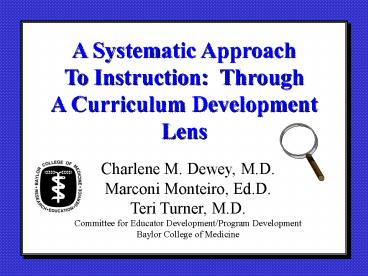Curriculum 101: Making Learning Interactive and Fun - PowerPoint PPT Presentation
1 / 30
Title: Curriculum 101: Making Learning Interactive and Fun
1
A Systematic Approach To Instruction Through A
Curriculum Development Lens
Charlene M. Dewey, M.D. Marconi Monteiro,
Ed.D. Teri Turner, M.D. Committee for Educator
Development/Program Development Baylor College of
Medicine
2
BASIC ASSUMPTIONS
- Learner centered
- Interdependent components, a change in one
component will affect another - Instruction can be improved over time
3
It is curious that so many of our most important
responsibilities are undertaken without
significant preparation. . The task of medical
teaching, on the other hand, is accepted
deliberately and dispassionately, yet the
preparation for that influential role is equally
frail. GE Miller 1980 in Educating Medical
Teachers
4
Committee for Educator Development
Program Development
Mini- Fellowships
Evaluation Feedback
Curriculum Development
Large Group Lecture Skills
Nuts Bolts of ARS
Demystifying Power Point
1) Teaching in small groups 2) Curriculum
design
5
GOAL
- The goal of this session is
- to introduce you to the systematic approach
of instruction through curriculum design and to
provide a template upon which one can build all
teaching encounters in a systematic fashion
6
Objectives
- By the end of this session the learner will be
able to - Identify factors that affect planning and
delivery of instruction - List the steps involved in developing a
curriculum - Write learning objectives, educational methods
and evaluation strategies for an instructional
activity - To list reasons to use a systematic approach in
all teaching encounters
7
A Systematic Approach to Instruction
Program Planning
Instructional Objectives
Program Evaluation
Instruction
Evaluation of Learners
8
- Research
- Research Question
- Literature
- Hypothesis Testing
- Design
- Do The Study
- Results
- Clinical
- Patient Complaint
- Differential Diagnosis
- Management Plan
- Treatment
- Compliance
- Follow-up Results
- Education
- Problem Identification
- Needs Assessment
- Goals Objectives
- Educational Strategies
- Implementation
- Evaluation/Feedback
9
STEP 1 PROBLEM IDENTIFICATION
10
STEP 2 NEEDS ASSESSMENT
ACTUAL
OPTIMAL
NEEDS Your curriculum
11
Needs Assessment
- Areas to Consider
- People involved
- Content
- Resources
- Sources of Needs
- Learners
- Program
- Institution
- Community
- Society
12
STEP 3 GOALS AND OBJECTIVES
13
If you dont know where you are going .
You might end up somewhere else
14
The ABCDs of Objectives
A B C D
Audience Behavior Condition Degree
Who Will do what Under what condition(s) How
much/well
15
The participants, will list the 6 steps involved
in developing curricula by the end of the workshop
The participants
will list
6 steps
by the end
16
DONT USE THESE VERBS
- UNDERSTAND
- KNOW
- APPRECIATE
- BELIEVE
- INTERNALIZE
- ENJOY
17
CURRICULUM DESIGN WORKSHEET Name of the
Course/Program
Topic Goal
18
STEP 4 EDUCATIONAL METHODS
19
METHODS
- If you only know how to use a HAMMER then
every problem is a NAIL.
20
Educational methods
- Readings
- Lecture
- Site visits
- Small group discussions
- Demonstrations
- Audio/visual materials
- Role plays
- Simulated experiences
- Case presentations
- Computer-assisted
- Learning activities
- Actual experiences
- Paper cases
21
(No Transcript)
22
STEP 5 IMPLEMENTATION
Where the rubber hits the road.
23
Implementation Tips
- Consider different perspectives on implementation
- Technological
- Political
- Cultural
- Consider the people around you that will help you
implement the program
- Prepare beforehand
- Formats, sequence, instructional materials,
audiovisuals, etc. - Implementation checklist
- Be flexible
24
Example of an Implementation Checklist
25
STEP 6 EVALUATION STRATEGIES
26
Evaluation
- Its not what you EXPECT but what you INSPECT
that learners see as important
27
Evaluation strategies
- Record review
- Observation/video
- Checklist
- Standardized patients
- OSCE
- Evaluations
- Self assessment
- Simulations
- Portfolios
- Examination
- Logs
- Patient surveys
- Participation
- Presentations
28
Curriculum Design Process The Six-Step Approach
Steps 1 2 Problem Identification Needs
Assessment
Steps 3 4 Goals Objectives Instructional
Methods
Steps 6 Evaluation Feedback
Step 5 Implementation Plan Pilot Full
Implementation
29
WHY BE SYSTEMATIC?
- Focus time and effort on the right solution
- May help achieve buy-in
- Lends credibility because you use the same
approach one takes for research or for seeing
patients - Ensures work is scholarly
- Leads to further refinement and improvement
30
Anybody who believes that all you have to do to
be a good teacher is to love to teach also has to
believe that all you have to do to become a good
surgeon is to love to cut.
L. Mansnersus. The New York Times. November 7,
1993 Section 4A































